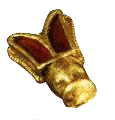A Note on Childeric's Bees

On May 27, 1653 a mason, Adrien Quinquin, working on the reconstruction of the church of Saint-Brice in Tournai, discovered a Merovingian tomb containing various articles, including a leather purse containing gold coins, a gold bracelet, some pieces of iron, and numerous pieces of gold cloisonnéed with garnets, among these the 300 bees. One of the pieces was a ring with the inscription CHILDERIC REGIS, identifying the tomb as that of Childeric I, father of Clovis. The discovery excited great interest in Tournai and Brussels. Archduke Leopold William, Spanish governor of the Netherlands, put his personal physician, Jean-Jacques Chifflet, in charge of studying and publishing the finds. In 1655 he published his work, Anastasis Childerici I Francorum regis, sive thesaurus sepulchralis Tornaci Neviorum effossus et commentario illustratus.
Leopold William took the treasure to Vienna when he left the Netherlands in 1656. On his death, the treasure became the property of the Emperor of Austria, Leopold I. In 1665 Leopold gave the treasure to Louis XIV as a gift in recognition of the help of the French against the Turks and against a revolt of Austrian subjects in Hungary.
The French monarch had considerably less interest in the treasure than had the Austrians. The relics were first placed in the royal collections of the Louvre, then transferred to the Bibliothèque royale (now the Bibliothèque national), where they were apparently little regarded and somewhat difficult of access. They were stolen in the night of November 5-6, 1831. The records of the police search and the trial that followed were unfortunately destroyed during the Commune, but it is clear that the thieves melted the larger gold pieces and hid the smaller, less easily melted pieces (like cloisonné) in the Seine, from which they were retrieved in August of 1832. While about 75 of about 80 kg of stolen artifacts were recovered, the missing pieces included much of the treasure of Childeric. It seems that only two of the bees were recovered. Fortunately, the work of Chifflet was extremely thorough, so that we have very good descriptions and engravings of the missing pieces. In addition, copies were made by Emperor Leopold before the originals were given to Louis XIV; some of these have been recovered in Innsbruck.
A couple of the bees, a large picture at Gallica (note the “scratching” under the garnet, a trademark of Merovingian cloisonné); Napoleonic Heraldry, how he got the bees. The page says that the originals are eagles, without further comment. I have seen no opinion based on an inspection of the objects (rather than the uses to which they have been put) that is consonant with this conjecture. Some experts have suggested that the insects are flies. They look like shuttlecocks to me and I'm sure that the ancient-alien crowd has loads of interesting opinions on the question.
This page is by James Eason.
